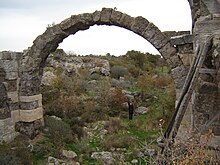Alexandria Troas
Αλεξάνδρεια Τρωάς Eski Stambul | |
 Thermae in Aleaxandria Troas | |
| Alternative name | Sigeia, Antigonia Troas, Colonia Alexandria Augusta Troas, Troas |
|---|---|
| Location | Dalyan, Çanakkale Province, Turkey |
| Region | Troad |
| Coordinates | 39°45′06″N 26°09′31″E / 39.75167°N 26.15861°E |
| Type | Settlement |
| Area | 400 ha (990 acres) |
Alexandria Troas ("Alexandria of the
Bozcaada). It is located southeast of modern Dalyan, a village in the Ezine district of Çanakkale Province. The site sprawls over an estimated 400 hectares (990 acres); among the few structures remaining today are a ruined bath, an odeon, a theatre, gymnasium complex[1] and a recently uncovered stadion.[2]
The circuit of the old walls can still be traced.
History
Hellenistic
According to
Constantine considered making Troas the capital of the Roman Empire.[7]
Roman
In Roman times, it was a significant port for travelling between
of Tarsus sailed for Europe for the first time from Alexandria Troas[8] and returned there from Europe (it was there that the episode of the raising of Eutychus is said to have occurred[9]). Ignatius of Antioch also paused at this city before continuing to his martyrdom at Rome.[10]
Byzantine
Several of its later
Georgii Cyprii descriptio orbis romani, 64); it is not known when the city was destroyed and the diocese disappeared. The bishopric remains a titular see of the Catholic Church under the name Troas, vacant since 1971.[11]
Troas is also a titular see of the
Metropolitan Savas (Zembillas) of Pittsburgh in the Greek Orthodox Archdiocese of America.[13]
Ottoman
beylik was conquered by the Ottomans in 1336. The ruins of Alexandria Troas came to be known among the Turks as Eski Stambul, the "Old City".[1] The site's stones were much plundered for building material (for example Mehmed IV took columns to adorn his Yeni Valide Mosque in Istanbul). As of the mid-18th century the site served as "a lurking place for bandetti".[14]
Modern
By 1911, the site had been overgrown with
Vallonea oaks
and much plundered, but the circuit of the old walls could still be traced, and in several places they were fairly well preserved.
They had a circumference of about ten kilometres, and were fortified with towers at regular intervals.[15]
Remains of an ancient bath and gymnasium complex can be found within this area; this building is locally known as Bal Saray (Honey Palace) and was originally endowed by Herodes Atticus in the year 135.[1] Trajan built an aqueduct which can still be traced.[15]
The harbour had two large basins, now almost choked with sand.
It is the subject of an early twenty-first century study by German archaeologists digging and surveying at the site.
Their excavation uncovered the remains of a large stadium dating to about 100 BC.[2]
See also
References
- ^ a b c d John Freely (2003). The Aegean Coast of Turkey. Redhouse Press, Istanbul, pp.3-8.
- ^ a b Gina Jacobs (2010). Remnants of Glory: A "found" stadium conjures Olympic history. Retrieved 2010-4-15.
- ^ Strabo, Geography, 13.47
- ^ a b Jona Lendering (2006). Alexandria in Troas Archived 2013-10-30 at the Wayback Machine (from Livius.org). Retrieved 2010-4-15.
- ^ a b Robert Jewett (2005). The Troas Project: Investigating Maritime and Land Routes to Clarify the Role of Alexandria Troas in Commerce and Religion. Archived 2011-07-19 at the Wayback Machine Retrieved 2010-4-15.
- ^ Pliny, Naturalis Historia 5:124.
- ^ Vailhé, Siméon (1912). . In Herbermann, Charles (ed.). Catholic Encyclopedia. Vol. 15. New York: Robert Appleton Company.
- ^ Paul of Tarsus. Acts 16:8-11.
- ^ Acts 20:5-12.
- ^ Ignatius of Antioch. Ad Philad. 11:2; Ad Smyrn. 12:1.
- ISBN 978-88-209-9070-1), p. 997
- ^ Greek Orthodox Archdiocese of America (2002-1-28). Ordination of Bishop-Elect Savas Zembillas on Saturday, February 2, 2002 at Holy Trinity Cathedral. Archived 2010-06-13 at the Wayback Machine Retrieved 2010-4-15.
- ^ Greek Orthodox Archdiocese of America (2011-11-3). Bishop Savas of Troas Elected Metropolitan of Pittsburgh Archived 2011-11-04 at the Wayback Machine. Retrieved 2011-11-17.
- ^ Richard Chandler. Travels in Asia Minor, 1764-65. Quoted in Freely, op. cit.
- ^ a b Hogarth, David George (1911). . In Chisholm, Hugh (ed.). Encyclopædia Britannica. Vol. 1 (11th ed.). Cambridge University Press. p. 575.
Bibliography
- Feuser, Stefan, Der Hafen von Alexandria Troas (Bonn: Dr. Rudolf Habelt, 2009) (Asia Minor Studien, 63).
External links
![]() Media related to Alexandria Troas at Wikimedia Commons
Media related to Alexandria Troas at Wikimedia Commons

